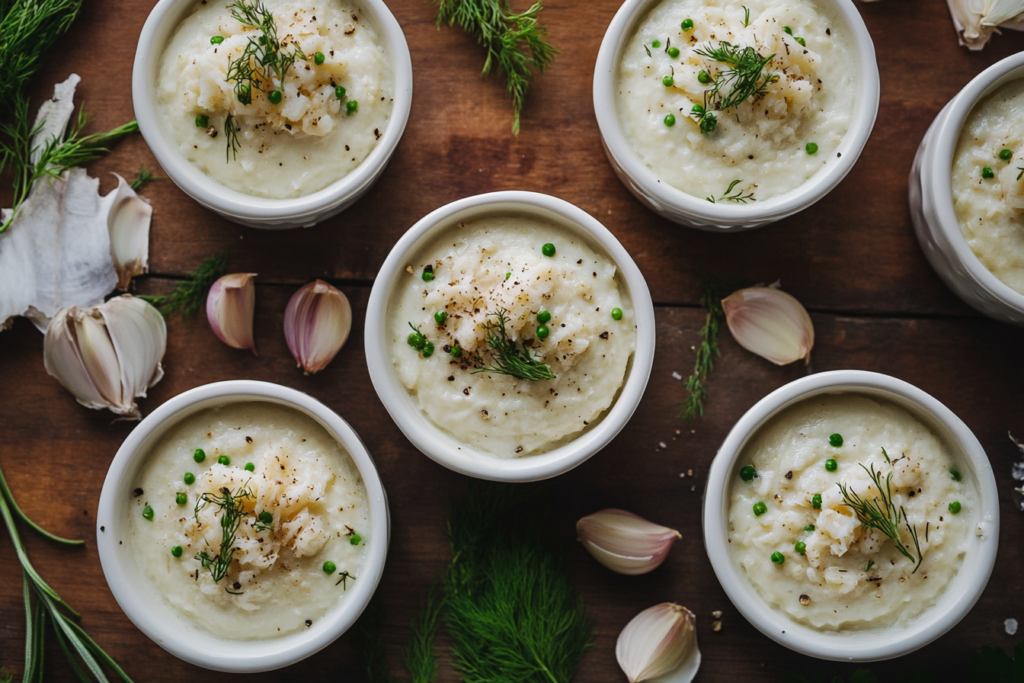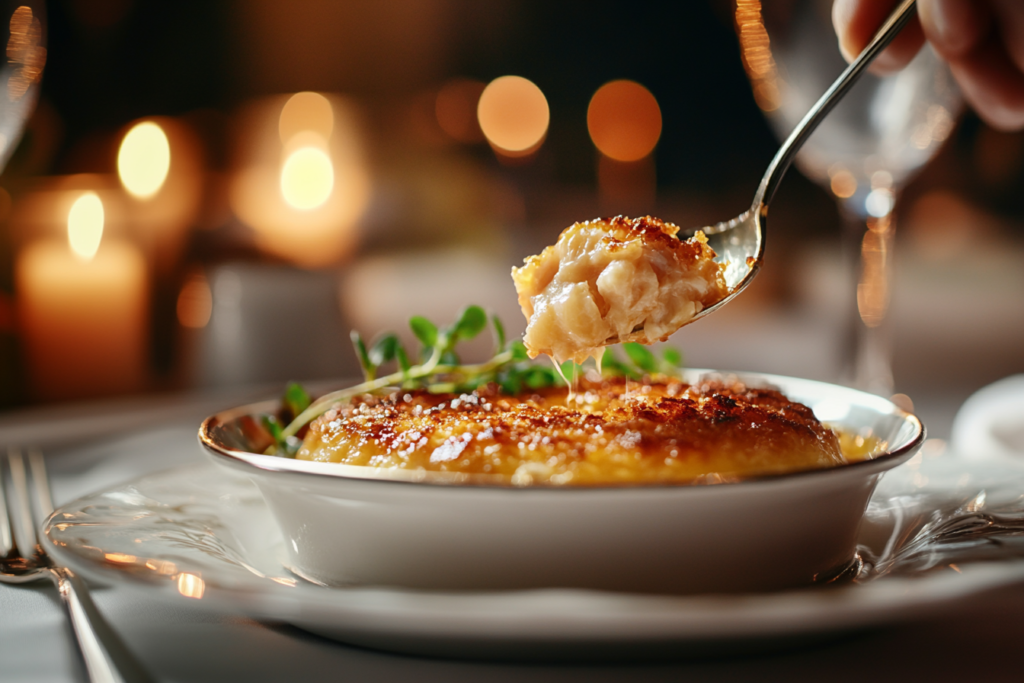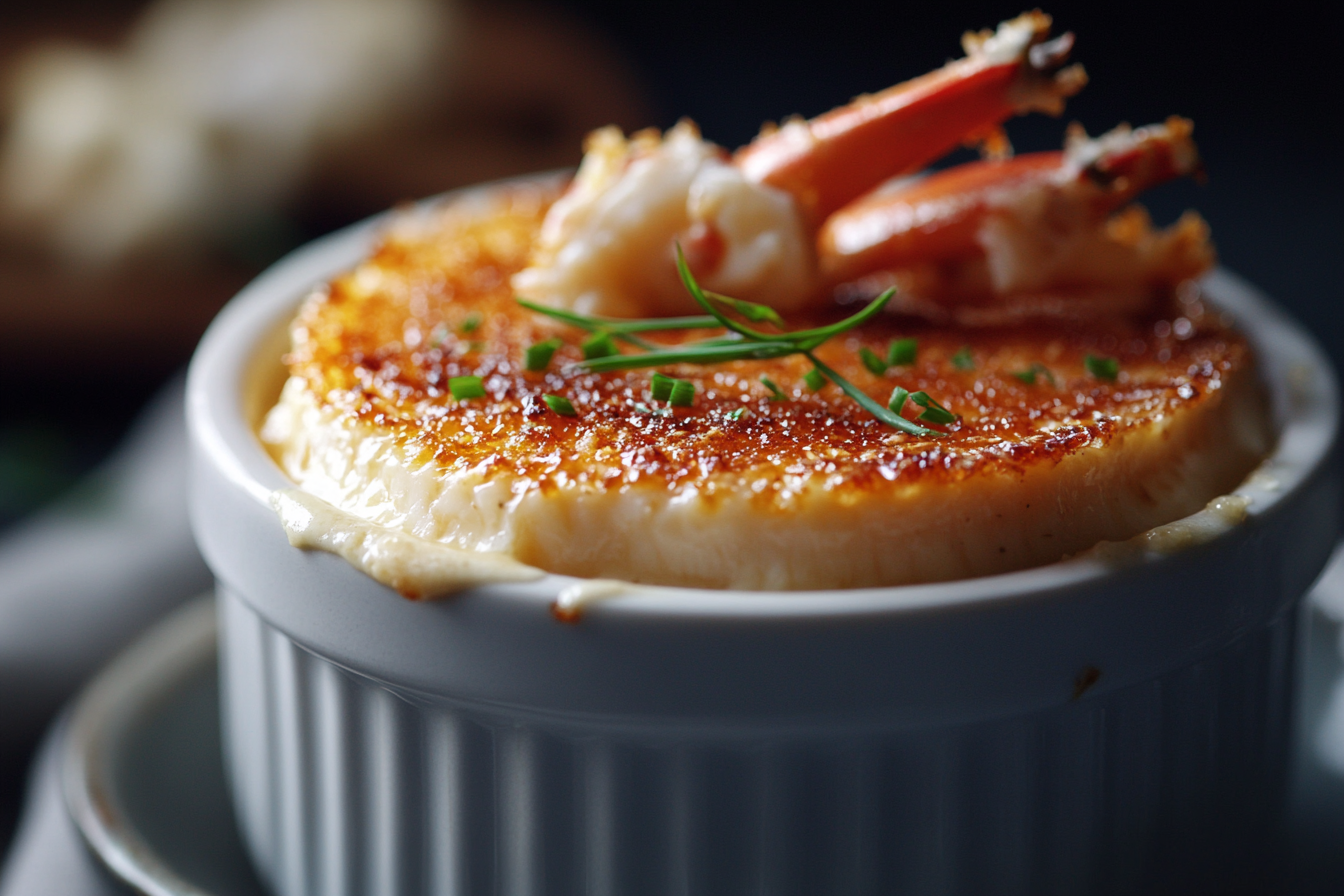A Savory Crab Brûlée Recipe Made with Crab Meat: A Decadent Delight
Making crème brûlée savory sounds like a culinary dream, right? Enter savory crab brûlée, a dish that’s as elegant as it is delicious. By combining the creamy texture of a classic custard with the sweet, delicate flavor of crab meat, this recipe creates a standout dish perfect for special occasions or impressing guests. Let’s dive into this flavorful journey, exploring every step, from selecting ingredients to perfecting the caramelized topping.
Introduction to Savory Crab Brûlée
A savory crab brûlée is an innovative twist on the timeless crème brûlée dessert, transforming it into an appetizer or main course. The traditional custard—made with cream, egg yolks, and sugar—gets a savory makeover, with the sweetness replaced by succulent crab meat and delicate seasonings. When combined with a crackling sugar crust, this dish embodies the perfect balance of textures and flavors.
Crab brûlée draws inspiration from culinary pioneers who dared to push boundaries. This dish is a testament to creativity, blending French techniques with the seafood-rich traditions of coastal cuisines. While crème brûlée typically graces dessert menus, this savory adaptation demonstrates how versatile the concept can be.
The Unique Appeal of Crab Brûlée
Flavor Profile
What sets savory crab brûlée apart is its delightful balance of rich, creamy custard and the natural sweetness of crab meat. The custard, velvety and smooth, serves as the perfect canvas for the delicate seafood flavor. Adding a caramelized sugar crust creates a satisfying crunch, delivering that unmistakable brûlée experience. This combination of textures and flavors is, quite simply, culinary magic.
For those who enjoy exploring unusual pairings, crab brûlée offers a surprising yet delightful mix of sweet and savory. Each bite melts in your mouth, leaving behind a symphony of creamy richness and subtle seafood undertones.
Culinary Significance
Crab brûlée isn’t just a dish—it’s an experience. This recipe reflects the growing trend of reimagining traditional classics, appealing to diners seeking unique flavor combinations. The interplay of textures makes this dish a conversation starter, ideal for dinner parties or as a signature offering in upscale dining settings.
Selecting the Best Crab Meat for Brûlée
Types of Crab Meat
Choosing the right crab meat is essential for making the perfect savory crab brûlée. Lump crab meat, with its tender, juicy flakes, is a popular choice for its balance of flavor and texture. Jumbo lump crab meat, on the other hand, offers larger, more luxurious chunks, making it an excellent option for indulgent presentations. Claw meat, slightly stronger in flavor, works well if you want to add a more pronounced seafood note to the dish.
Fresh vs. Canned
The quality of crab meat can make or break your brûlée. While fresh crab meat delivers unbeatable flavor and texture, canned crab meat is a convenient alternative. If you opt for canned, look for high-quality brands labeled “lump” or “jumbo lump” and ensure the meat is packed in water or brine, not oil. However, for the ultimate experience, fresh crab meat is worth the effort. It brings an unmatched freshness that elevates the custard to new heights.
Essential Ingredients for Crab Brûlée
Crafting a delicious savory crab brûlée begins with gathering the right ingredients. Each element plays a crucial role in balancing the creamy custard with the delicate flavors of crab meat.

Core Components
- Fresh Crab Meat: The star of the dish, fresh lump or jumbo lump crab meat adds a naturally sweet and tender texture. Opt for freshly cooked crab for optimal flavor.
- Heavy Cream: This rich, velvety ingredient forms the base of the custard, lending a luscious texture that contrasts beautifully with the caramelized sugar topping.
- Egg Yolks: These are essential for creating the smooth, creamy consistency that defines crème brûlée.
- Granulated Sugar: While savory, this recipe still uses sugar to create the signature brûlée topping, adding a subtle touch of sweetness and crunch.
- Seasonings: A pinch of salt, a dash of cayenne pepper, and a hint of paprika enhance the savory profile, complementing the natural sweetness of the crab.
Optional Additions
- Garlic: Minced garlic adds depth, introducing a mild pungency that balances the dish’s creaminess.
- Parmesan Cheese: A sprinkle of grated Parmesan can boost the umami factor, creating a more robust flavor.
- Pickled Ginger: For a unique twist, pickled ginger adds a touch of tang and spice, cutting through the richness of the custard.
Necessary Equipment for Preparation
To make savory crab brûlée, you’ll need some essential tools. The right equipment not only simplifies the process but ensures a flawless result.
Kitchen Tools
- Ramekins: Individual ramekins are perfect for portioning the custard and achieving even cooking.
- Mixing Bowls and Whisk: Use these for combining and aerating the custard mixture.
- Roasting Tray: A sturdy tray for holding the ramekins in a water bath during baking.
Specialized Tools
- Kitchen Torch: This indispensable tool creates the brûlée’s iconic caramelized sugar crust. A broiler can substitute in a pinch, but the torch offers precise control.
- Strainer: For a silky-smooth custard, strain the mixture to remove any egg solids or lumps.
Step-by-Step Preparation Guide
Creating savory crab brûlée might seem daunting, but by breaking it down into manageable steps, you’ll find it’s quite achievable.
Preparing the Custard Base
- Combine Ingredients: In a mixing bowl, whisk together 5 large egg yolks and 1/4 cup of sugar until the mixture turns pale yellow. This step ensures the custard will set correctly.
- Add Cream: Gradually whisk in 1 1/2 cups of heavy cream. Be gentle to avoid incorporating too much air.
- Season and Fold in Crab: Add a pinch of salt, a dash of cayenne, and any optional seasonings you like. Finally, fold in 1 cup of fresh lump crab meat, being careful not to break the pieces apart.
Assembling the Brûlée
- Prepare Ramekins: Lightly grease the ramekins to prevent sticking, then place them in a roasting tray.
- Pour and Strain: Pour the custard mixture through a fine strainer directly into the ramekins. This step ensures a smooth and creamy texture.
- Create a Water Bath: Fill the roasting tray with hot water until it reaches halfway up the sides of the ramekins. This prevents the custard from overcooking or curdling.
Baking Instructions
- Preheat and Bake: Preheat your oven to 325°F (163°C). Bake the custards for 30–35 minutes, or until the edges are set but the centers jiggle slightly when shaken.
- Cool Down: Remove the ramekins from the water bath and let them cool at room temperature. Then, refrigerate for at least 2 hours to fully set.
Caramelizing the Sugar Topping
Sugar Application
The caramelized sugar crust is the hallmark of any savory crab brûlée. Achieving that perfect, glass-like layer begins with an even sprinkling of sugar. Start by adding 1–2 teaspoons of granulated sugar per ramekin. Tilt and rotate each ramekin to spread the sugar uniformly over the surface. Ensure no bare spots or thick clumps, as this will affect the caramelization.
For a slightly more sophisticated flavor, you can substitute granulated sugar with raw sugar or superfine sugar. These alternatives melt more evenly and create a richer golden hue.
Torching Method
Using a kitchen torch is the easiest and most effective way to create the classic brûlée crust. Hold the torch a few inches above the ramekin, moving it in slow, circular motions. This method allows the sugar to melt evenly, bubble slightly, and form a golden-brown crust. Take care not to linger in one spot to avoid burning.
If a kitchen torch isn’t available, a broiler can be used as a substitute. Place the ramekins on a baking sheet and broil on high for 1–2 minutes. Keep a close eye to prevent over-browning.
Serving Suggestions and Pairings
Presentation Tips
Presentation can truly elevate savory crab brûlée from simply delicious to utterly dazzling. After caramelizing the sugar, it’s important to allow the ramekins to cool for a minute or two. This brief resting period ensures the sugar crust sets perfectly without losing its crisp texture. Next, garnish the brûlée with a sprig of fresh parsley or, for a creative touch, a delicate sliver of pickled ginger. These additions not only enhance its gourmet appeal but also introduce a pop of color.
For an extra layer of luxury, consider sprinkling finely grated Parmesan or lightly dusting smoked paprika over the top. Not only does this add visual flair, but it also complements the dish’s savory notes beautifully.

When serving, place each ramekin on a small plate with a folded napkin or a decorative doily underneath. This extra detail helps stabilize the ramekin while adding a touch of elegance. Finally, accompany the dish with a small spoon, inviting diners to experience the satisfying crack of the sugar crust before savoring the creamy custard beneath.
Accompaniments
Pairing savory crab brûlée with the right sides can make it the star of a well-rounded meal. Consider serving it alongside a light arugula salad with citrus vinaigrette, a crusty baguette, or roasted vegetables. These sides provide a refreshing contrast to the rich custard.
For non-alcoholic drink pairings, iced herbal tea, sparkling water with lemon, or a chilled cucumber mocktail complement the dish beautifully, enhancing its delicate flavors without overwhelming the palate.
Variations and Dietary Modifications
Ingredient Substitutions
Making savory crab brûlée suitable for different diets or preferences is simple with a few swaps. For a seafood-free version, substitute the crab meat with finely diced mushrooms, such as shiitake or cremini, to replicate the umami flavor. Dairy-free heavy cream alternatives, like coconut cream or cashew cream, can replace traditional cream while maintaining the dish’s signature texture.
If fresh crab meat is unavailable, cooked lobster, shrimp, or even canned crab meat can be excellent substitutes. These alternatives still offer a seafood-forward profile while accommodating ingredient availability.
Flavor Enhancements
For those eager to experiment, the custard base offers a wonderfully versatile canvas for exploring bold and exciting flavors. To begin, herbs such as dill, thyme, or tarragon can be incorporated to infuse the mixture with layers of aromatic depth. Moreover, these additions not only enhance the dish’s savory elements but also introduce a hint of freshness.
If you’re aiming for something with a global twist, spices like smoked paprika or curry powder can work wonders. While smoked paprika adds a subtle, smoky warmth, curry powder brings a complex medley of flavors that instantly elevates the custard to a more adventurous level. Additionally, for those seeking a brighter, more balanced flavor, folding in a dash of lemon zest can do the trick. The citrusy tang cuts through the custard’s richness, adding a refreshing vibrancy that complements the natural sweetness of the crab.
Nutritional Information
When enjoying savory crab brûlée, it’s worth understanding its nutritional profile. While indulgent, the dish can fit into a balanced diet when consumed in moderation.
Caloric Content
A single serving of crab brûlée contains approximately 250–300 calories, depending on portion size and ingredient variations. The majority of these calories come from the rich custard base, which includes heavy cream and egg yolks.
Macronutrient Breakdown
- Protein: Around 12–15 grams per serving, thanks to the crab meat and egg yolks.
- Fat: Roughly 18–22 grams, primarily from the cream and egg yolks, giving the custard its luxurious texture.
- Carbohydrates: About 6–10 grams, primarily from the sugar used in the brûlée topping.
This dish is rich and satisfying, making it a great choice for special occasions.
Common Mistakes to Avoid
Even with a simple recipe, a few missteps can hinder your results. Let’s troubleshoot some common issues to ensure your savory crab brûlée is flawless.
Overcooking the Custard
One of the most frequent errors is overcooking, which can lead to a rubbery texture. To avoid this, keep a close eye on the baking time. The custard should jiggle slightly in the center when shaken—it will set fully as it cools. Using a water bath is crucial for gentle, even heat distribution.
Uneven Caramelization
Achieving a uniform sugar crust requires technique. Avoid sprinkling sugar unevenly or using too much, as these can lead to burning or clumping. Use a steady hand when applying the torch, moving in smooth, circular motions to melt the sugar evenly without scorching.
Frequently Asked Questions (FAQs)
Here are answers to some common questions about making and serving savory crab brûlée.
What is the best type of crab for crab brûlée?
Fresh lump or jumbo lump crab meat is ideal due to its sweet flavor and tender texture. Avoid imitation crab, as it lacks the natural flavor profile necessary for this dish.
Can crab brûlée be made ahead of time?
Yes! You can prepare the custard and refrigerate it for up to 24 hours before caramelizing the sugar topping. Wait to brûlée the sugar until just before serving for the best texture.
How do I store leftover crab brûlée?
Cover the ramekins with plastic wrap and store them in the refrigerator for up to 2 days. For optimal freshness, consume within 24 hours.
Is a kitchen torch necessary, or can I use the oven broiler?
A kitchen torch offers more control and precision, but a broiler can work as a substitute. Place ramekins under the broiler on high for 1–2 minutes, watching carefully to avoid burning.
What does crab brûlée taste like?
It’s a delightful blend of creamy, savory custard with the sweet, delicate flavor of crab, topped with a crunchy caramelized sugar crust. It’s unique and indulgent!
Can I freeze crab brûlée?
Freezing is not recommended, as the custard’s texture may become grainy once thawed.
Expert Tips for Perfecting Crab Brûlée
Achieving Smooth Custard
For a silky custard, strain the mixture before pouring it into ramekins. This step removes any egg solids or lumps, ensuring a velvety texture.
Flavor Balance
Be mindful of the balance between sweet and savory. A slight touch of sugar in the custard enhances the crab’s natural sweetness without overpowering it. Taste as you go, adjusting seasonings like salt or cayenne sparingly.
Exploring Other Savory Brûlée Variations
Lobster Brûlée
If you’re feeling adventurous, lobster meat is an excellent substitute for crab. Its rich, buttery flavor pairs wonderfully with the creamy custard base.
Vegetarian Options
For a seafood-free twist, consider using roasted vegetables like mushrooms or asparagus. Cheeses such as Gruyère or Brie can also serve as flavorful substitutes, creating an equally indulgent dish.
Conclusion: Embracing Culinary Creativity
A savory crab brûlée recipe offers a unique way to push your culinary boundaries, blending classic techniques with bold, modern flavors. From selecting quality crab meat to perfecting the caramelized topping, every step contributes to a dish that’s as impressive as it is delicious. Whether you stick to the classic recipe or experiment with variations, this dish is a testament to the endless possibilities of creative cooking. Dive in and discover the joy of crafting a masterpiece!


4 thoughts on “A Savory Crab Brûlée Recipe Made with Crab Meat: A Decadent Delight”